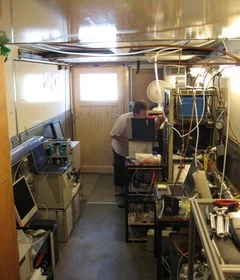Scope of project
- Quantification of the atmospheric aging processes of BC particles in field experiments near sources and at remote locations.
- Investigation of the influence of BC mixing state on its activation behavior in liquid clouds.
- Measurement of BC histories by high resolution analysis of ice core records.
- Laboratory experiments for a detailed characterization of the SP2.
Laboratory and field experiments
- Analysis of a Mt. Everest ice core, Laboratory of Radiochemistry and Environmental Chemistry at PSI, Switzerland, 2009-2010
- WOODIESEL, PSI's smogchamber, Switzerland, 2009-2010
- MEGAPOLI, Paris, France, 2009-2011
- Effective density measurements, Particle Technology Laboratory at ETH Zürich, 2010
- CLACE, Jungfraujoch, Switzerland, 2010
- SOOT11, AIDA chamber Karlsruhe, Germany, 2010
Key findings
- BC concentrations in a Mt. Everest ice core spanning 1860-2000 AD have been shown to increase approximately threefold from 1975–2000 relative to 1860–1975, indicating that BC from anthropogenic sources is being transported to high elevation regions of the Himalaya. This suggests that a reduction in BC emissions may be an effective means to reduce the effect of absorbing impurities on snow albedo and melt, which affects Himalayan glaciers and the availability of water resources in major Asian rivers.
- The effective density of fullerene soot and Aquadag - two common SP2 calibration materials - has been shown to be stable and independent of aerosol generation procedures. Size-resolved effective density data are provided, which makes it possible to use a differential mobility analyzer for accurate SP2 calibrations.
- Primary particulate matter in fresh exhaust from a diesel car without particle filter is dominated by black carbon with a small amount of organic carbon. Subsequent aging of the exhaust by photochemical oxidation resulted in the formation of substantial amounts of secondary organic aerosol (SOA) for cars without a diesel oxidation catalyst (DOC), whereas the SOA formation was minimal for cars equipped with a DOC.
Publications
Journal Articles
Effective density of Aquadag and fullerene soot black carbon reference materials used for SP2 calibration.
Gysel, M., M. Laborde, J. S. Olfert, R. Subramanian, and A. J. Gröhn, 2011
Atmos. Meas. Tech. Discuss., 4, 4937-4955.
DOI: 10.5194/amtd-4-4937-2011
Recent increase in black carbon concentrations from a Mt. Everest ice core spanning 1860-2000 AD.
Kaspari, S. D., M. Schwikowski, M. Gysel, M. G. Flanner, S. Kang, S. Hou, and P. A. Mayewski, 2011
Geophys. Res. Lett., 38, L04703.
DOI: 10.1029/2010GL046096
Impact of aftertreatment devices on primary emissions and secondary organic aerosol formation potential from in-use diesel vehicles: results from smog chamber experiments.
Chirico, R., P. F. DeCarlo, M. F. Heringa, T. Tritscher, R. Richter, A. S. H. Prévôt, J. Dommen, E. Weingartner, G. Wehrle, M. Gysel, M. Laborde, and U. Baltensperger, 2010
Atmos. Chem. Phys., 10, 11545-11563.
DOI: 10.5194/acp-10-11545-2010


